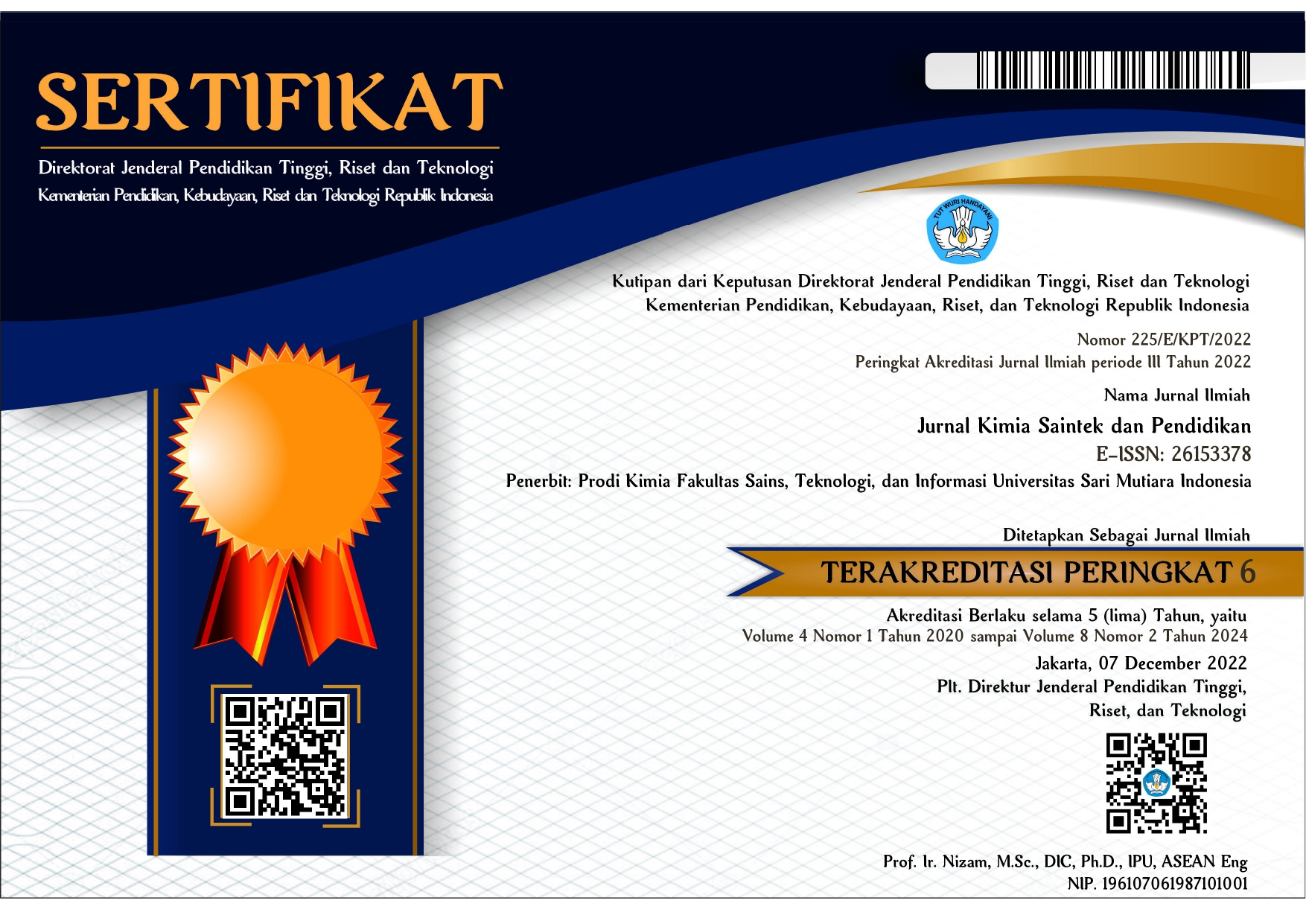PENGARUH BENZOIL PEROKSIDA SEBAGAI INISIATOR REAKSI ANTARA ASPAL, POLIPROPILENA, DAN KARET BAN MELALUI METODE INTERPENETRASI JARINGAN POLIMER (IJP)
Keywords:
Benzoil Peroksida, Aspal, Polipropilena, Karet Ban, Interpenetrasi Jaringan Polimer.Abstract
Penelitian mengenai pengaruh benzoil peroksida sebagai inisiator reaksi antara aspal, polipropilena, dan karet ban melalui metode interpenetrasi jaringan polimer telah dilakukan. Tujuan dari penelitian ini adalah untuk mengetahui pengaruh dari benzoil peroksida dalam meningkatkan sifat mekanik yang ditinjau dari uji kuat tarik pada campuran aspal, polipropilena, dan karet ban yang dibuat melalui metode Interpenetrasi Jaringan Polimer (IJP), serta karakterisasinya. Penelitian ini dilakukan dengan mencampurkan dua material polimer yaitu plastik polipropilena yang telah dilarutkan dengan xylene dan karet ban bekas, keduanya dimasukkan ke dalam gelas beaker dan dipanaskan pada suhu 160 oC sambil diaduk hingga homogen, yang kemudian ditambahkan dengan aspal, lalu ditambahkan inisiator BPO yang divariasikan, campuran tersebut dicetak dan diratakan dengan mesin hot kompressor pada suhu 165 oC. Hasilnya dilakukan uji kuat tarik dimana diperoleh nilai kuat tarik maksimum sebesar 66,38 MPa pada variasi penambahan BPO sebanyak 5 phr untuk campuran aspal 60%, polipropilena 35%, dan karet ban 5%. Hasil analisis dengan spektroskopi FTIR menunjukkan adanya ikatan silang antara gugus hidroksil dari aspal dengan polipropilena melalui reaksi radikal yang diinisiasi oleh adanya benzoil peroksida, analisis termal dengan DTA menunjukkan adanya perubahan suhu dekomposisi sebesar 405 oC yang berarti terjadi pembentukan material baru, dan untuk karakterisasi morfologi dengan SEM menunjukkan adanya perubahan struktur permukaan pada campuran aspal setelah penambahan polipropilena dan karet ban.
Kata Kunci : Benzoil Peroksida, Aspal, Polipropilena, Karet Ban, Interpenetrasi Jaringan Polimer.
Abstract : Research on the effect of benzoyl peroxide as a reaction initiator between asphalt, polypropylene and tire rubber through Interpenetrating Polymer Network (IPN) method has been conducted. The aims of this study to determine the effect of benzoyl peroxide in improving mechanical properties in terms of tensile strength test on asphalt mixtures, polypropylene, and rubber tire made by Interpenetrating Polymer Network (IPN) Method, and its characterization. This research was carried out by mixing two polymeric materials of polypropylene plastic which have been dissolved with xylene and used tire rubber, both put into beaker glass and heated at 160 °C while stirring until homogeneous, then added with asphalt, and then added the BPO initiator varied, the mixture is molded and flattened with a hot compressor machine at a temperature of 165 °C. The result was a tensile strength test which obtained a maximum tensile strength value of 66.38 MPa in variation of 5 phr BPO addition for 60% asphalt mixture, 35% polypropylene, and 5% tire rubber. The analysis with FTIR spectroscopy shows the presence of crosslinking between hydroxyl groups from asphalt with polypropylene by radical reaction initiated by the presence of benzoyl peroxide, thermal analysis with DTA shows a change of decomposition temperature of 405 oC which means the formation of new material, and for morphological characterization with SEM indicates a change of surface structure on the asphalt mixture after the addition of polypropylene and tire rubber.
Keywords : Benzoyl Peroxide, Asphalt, Polypropylene, Tire Rubber, Interpenetrating Polymer Network.
Downloads
References
Endriani, D., & Ritonga, A. H. (2018). The influence of addition palm shell ash to mineralogy and physical properties of clay soil. ARPN Journal of Engineering and Applied Sciences, 13(4).
Kang, Y., Wang, F., & Chen, Z. (2010). Reaction of Asphalt and Maleic Anhydride: Kinetics and Mechanism. Chemical Engineering Journal, 164(1), 230–237.
Mothé, C. G., de Castro, B. C. S., & Mothé, M. G. (2011). Characterization By TG/DTG/DSC and FTIR of Frying and Fish Oil Residues To Obtain Biodiesel. Journal of Thermal Analysis and Calorimetry, 106(3), 811–817.
Polacco, G., Berlincioni, S., Biondi, D., Stastna, J., & Zanzotto, L. (2005). Asphalt Modification With Different Polyethylene-based Polymers. European Polymer Journal, 41(12), 2831–2844.
Rianung, S. (2007). Kajian Laboratorium Pengaruh Bahan Tambah Gondorukem pada Asphalt Concrete-Binder Course (AC-BC) Tehadap Nilai Propertis Marshall dan Durabilitas. Program Pasca Sarjana Universitas Diponegoro.
Ritonga, A. H. (2011). Pemanfaatan Karet Ban Bekas (Ground Rubber) Dan Polistirena Bekas Sebagai Bahan Aditif Dalam Pembuatan Aspal Polimer. Medan: USU.
Ritonga, A. H. (2017a). Karakterisasi Aspal Polimer Dari Limbah Polistirena dan Serbuk Karet Ban Bekas Menggunakan Divenil Benzena dan Inisiator Dikumil Peroksida. Akademia, 21(2), 7–14.
Ritonga, A. H. (2017b). Modifikasi Aspal Polimer Memanfaatkan Karet Ban Bekas Menggunakan Divenil Benzena dan Dikumil Peroksida Melalui Proses Ekstrusi. Jurnal Kimia Saintek Dan Pendidikan, I(2009), 8–13.
Ritonga, A. H. (2017c). Pembuatan Aspal Polimer Menggunakan Karet SIR-20 Yang Diinisiasi Oleh Adanya Dikumil Peroksida Melalui Proses Ekstrusi. Jurnal Stikna, 1(2), 123–130.
Satyarno, I. (2006). Penggunaan Serutan Karet Ban Bekas untuk Campuran Beton. Media Teknik, 28(2006).
Sitorus, M. (2009). Spektroskopi Elusidasi Struktur Molekul Organik. Graha Ilmu, Yogyakarta, 29–39.
Sitorus, N. H. (2016). Pembuatan Komposit Interpenetrasi Jaringan Polimer Antara Poliuretan-Karet Alam SIR-10 Dengan Penambahan Zeolit Sebagai Bahan Pengisi. Pembuatan Komposit Interpenetrasi Jaringan Polimer Antara Poliuretan-Karet Alam SIR-10 Dengan Penambahan Zeolit Sebagai Bahan Pengisi.
Thitithammawong, A., Nakason, C., Sahakaro, K., & Noordermeer, J. (2007). Effect of Different Types of Peroxides On Rheological, Mechanical, and Morphological Properties of Thermoplastic Vulcanizates Based On Natural Rubber/Polypropylene Blends. Polymer Testing, 26(4), 537–546.
Tortum, A., Çelik, C., & Aydin, A. C. (2005). Determination of The Optimum Conditions For Tire Rubber In Asphalt Concrete. Building and Environment, 40(11), 1492–1504.
Yeh, P. (2000). A Study of the Potential Use of Asphalt Containing Synthetic Polymers for Asphalt Paving Mixes. Disertation.
Zhang, B., Xi, M., Zhang, D., Zhang, H., & Zhang, B. (2009). The Effect of Styrene–Butadiene–Rubber/Montmorillonite Modification On The Characteristics and Properties of Asphalt. Construction and Building Materials, 23(10), 3112–3117.









 This work is licensed under a
This work is licensed under a 

.png)

